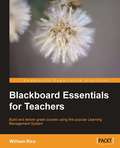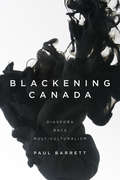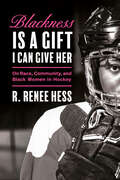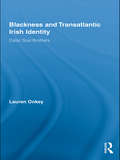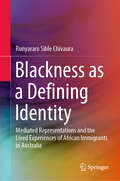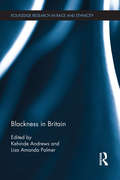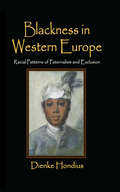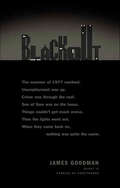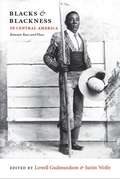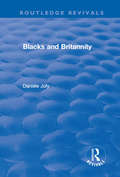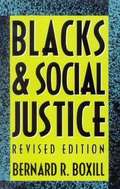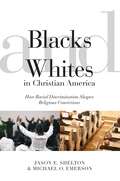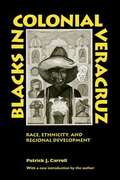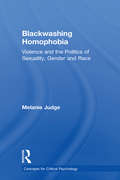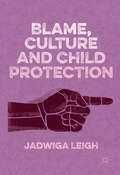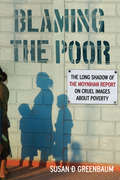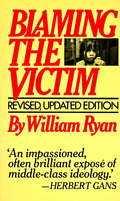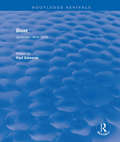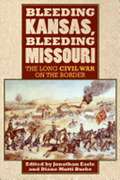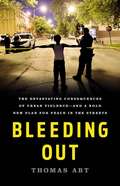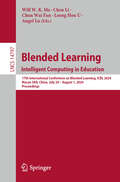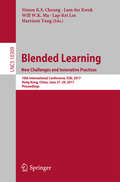- Table View
- List View
Blackberry Winter: My Earlier Years
by Margaret MeadThe autobiography of a pioneer, this is Margaret Mead's story of her life as a woman and as an anthropologist. An enduring cultural icon, she came to represent the new woman, successfully combining motherhood with career, and scholarship with concern for its role in the lives of ordinary people.
Blackboard Essentials for Teachers
by William RiceThis book develops a sample site with lots of step-by-step instructions and screenshots to get you up and running in no time at all. If you are a teacher or course builder, you need only basic computer skills to get the most from this book. You don't need any background in online teaching or building Web pages.
Blackening Canada
by Paul BarrettFocusing on the work of black, diasporic writers in Canada, particularly Dionne Brand, Austin Clarke, and Tessa McWatt, Blackening Canada investigates the manner in which literature can transform conceptions of nation and diaspora. Through a consideration of literary representation, public discourse, and the language of political protest, Paul Barrett argues that Canadian multiculturalism uniquely enables black diasporic writers to transform national literature and identity. These writers seize upon the ambiguities and tensions within Canadian discourses of nation to rewrite the nation from a black, diasporic perspective, converting exclusion from the national discourse into the impetus for their creative endeavours.Within this context, Barrett suggests, debates over who counts as Canadian, the limits of tolerance, and the breaking points of Canadian multiculturalism serve not as signs of multiculturalism's failure but as proof of both its vitality and of the unique challenges that black writing in Canada poses to multicultural politics and the nation itself.
Blackness Is a Gift I Can Give Her: On Race, Community, and Black Women in Hockey
by R. Renee HessFrom the founder of Black Girl Hockey Club, a collection of deeply insightful and piercing essays shedding light on the history of Black excellence in hockey, the future of Black joy within the sport, and the ways we can all do better when it comes to recognizing—and upheaving—systemic and institutionalized racism.Growing up, R. Renee Hess didn&’t care about hockey. In fact, she was barely aware of it. She was born and raised in Southern California, hardly a hotbed for the game, despite the state having three NHL teams. But, as Hess puts it, she is &“a fan of being a fan,&” and when she found herself stuck in traffic after a Pittsburgh Penguins game, the streets filled with cheers, something sparked within her. Ever since Hess made that discovery, she has been actively trying to bust the myth that &“Black folks don&’t like hockey.&”In this collection, Hess shares her hockey origin story and how she came to recognize hockey culture&’s lack of authentic engagement with Black communities, tracing her journey to becoming a true game changer. But, as an academic, Hess knows that her singular viewpoint can&’t tell the full story, so she reached out to former hockey players, league executives, activists, fans, media, and to the parents and youth shaping the future of the game. We hear directly from players such as Sarah Nurse and Saroya Tinker; from trailblazers like Bernice Carnegie and Kim Davis; and from the collective of Black Girl Hockey Club scholarship awardees and their families, emphasizing the importance of community and support for marginalized players. The result is a hockey book truly unlike any other.With essays that touch on representation and harmful stereotypes, the many nuanced aspects of biracial identity, being the only person of colour in the room, and the virtues of a lively group chat, Blackness Is a Gift I Can Give Her is a love letter to Black women everywhere, as well as a scathing ode to a game that Hess loves, even if it doesn't always love her back.
Blackness and Transatlantic Irish Identity: Celtic Soul Brothers (Routledge Research in Race and Ethnicity)
by Lauren OnkeyBlackness and Transatlantic Irish Identity analyzes the long history of imagined and real relationships between the Irish and African-Americans since the mid-nineteenth century in popular culture and literature. Irish writers and political activists have often claimed - and thereby created - a "black" identity to explain their experience with colonialism in Ireland and revere African-Americans as a source of spiritual and sexual vitality. Irish-Americans often resisted this identification so as to make a place for themselves in the U.S. However, their representation of an Irish-American identity pivots on a distinction between Irish-Americans and African-Americans. Lauren Onkey argues that one of the most consistent tropes in the assertion of Irish and Irish-American identity is constructed through or against African-Americans, and she maps that trope in the work of writers Roddy Doyle, James Farrell, Bernard MacLaverty, John Boyle O’Reilly, and Jimmy Breslin; playwright Ned Harrigan; political activists Bernadette Devlin and Tom Hayden; and musicians Van Morrison, U2, and Black 47.
Blackness as a Defining Identity: Mediated Representations and the Lived Experiences of African Immigrants in Australia
by Runyararo Sihle ChivauraThis book explores the lived experiences of African immigrants in Australia, and the way they are represented in the media. By delving into the group’s everyday lives, the book exposes the roles that media and social perceptions play in the production and regulation of diasporic identities. Rather than being presented as objects of mediated representations, this book positions African immigrants in Australia as empowered subjects. The book employs inclusive research methods that make African immigrants active participants in the research, rather than passive objects. This is achieved through an expanded demographic study, a snapshot survey, and by taking a closer look at the lives of Africans in Australia through digital oral histories. This approach allows the group to have a say on how they feel they are positioned in society, on what space they are offered, and on how this affects their lives.
Blackness in Britain: Retelling Black Radicalism For The Twenty-first Century (Routledge Research in Race and Ethnicity)
by Kehinde Andrews Lisa Amanda PalmerBlack Studies is a hugely important, and yet undervalued, academic field of enquiry that is marked by its disciplinary absence and omission from academic curricula in Britain. There is a long and rich history of research on Blackness and Black populations in Britain. However Blackness in Britain has too often been framed through the lens of racialised deficits, constructed as both marginal and pathological. Blackness in Britain attends to and grapples with the absence of Black Studies in Britain and the parallel crisis of Black marginality in British society. It begins to map the field of Black Studies scholarship from a British context, by collating new and established voices from scholars writing about Blackness in Britain. Split into five parts, it examines: Black studies and the challenge of the Black British intellectual; Revolution, resistance and state violence; Blackness and belonging; exclusion and inequality in education; experiences of Black women and the gendering of Blackness in Britain. This interdisciplinary collection represents a landmark in building Black Studies in British academia, presenting key debates about Black experiences in relation to Britain, Black Europe and the wider Black diaspora. With contributions from across various disciplines including sociology, human geography, medical sociology, cultural studies, education studies, post-colonial English literature, history, and criminology, the book will be essential reading for scholars and students of the multi- and inter-disciplinary area of Black Studies.
Blackness in Western Europe: Racial Patterns of Paternalism and Exclusion
by Dienke HondiusWhile the study of race relations in the United States continues to inspire and influence European thinking, Europeans have yet to confront their own history. To be black in Europe—whether during the sixteenth century or today—means sharing one crucial experience: being part of a small, but visible minority.European slave-owners, company directors, and investors in the distant past maintained an ocean-wide gap between themselves and the enslaved in the plantation colonies of the Caribbean. In the following centuries, this distance persisted. Even today, to be black in Europe often means to be one of a few black persons in a group. A racial pattern of exclusion has characterized European policy for more than four centuries.Dienke Hondius identifies ideas and attitudes toward "blackness," the concept of race as visible difference, developed in western Europe. She argues that racial discourses are generally dominated by paternalism—a concept usually used to explain power structures that is often applied to the nineteenth century. Hondius identifies five patterns of paternalism that influenced Europe much earlier and iniated trends of imagery and perception.Taking a chronological and thematic approach, Hondius first focuses on southern European societies in the Early Modern period and moves to northwest European societies in the Modern period. Addressing religion, law, and science, she concludes with a synthesis of developments from the twentieth century to the present.
Blackout
by James GoodmanOn July 13, 1977, there was a blackout in New York City. With the dark came excitement, adventure, and fright in subway tunnels, office towers, busy intersections, high-rise stairwells, hotel lobbies, elevators, and hospitals. There was revelry in bars and restaurants, music and dancing in the streets. On block after block, men and women proved themselves heroes by helping neighbors and strangers make it through the night.Unfortunately, there was also widespread looting, vandalism, and arson. Even before police restored order, people began to ask and argue about why. Why did people do what they did when the lights went out? The argument raged for weeks but it was just like the night: lots of heat, little light--a shouting match between those who held fast to one explanation and those who held fast to another.James Goodman cuts between accidents, encounters, conversations, exchanges, and arguments to re-create that night and its aftermath in a dizzying accumulation of detail. Rejecting simple dichotomies and one-dimensional explanations for why people act as they do in moments of conflict and crisis, Goodman illuminates attitudes, ideas, and experiences that have been lost in facile generalizations and analyses. Journalistic re-creation at its most exciting, Blackout provides a whirlwind tour of 1970s New York and a challenge to conventional thinking.
Blacks & Blackness in Central America: Between Race and Place
by Lowell Gudmundson Justin WolfeMany of the earliest Africans to arrive in the Americas came to Central America with Spanish colonists in the sixteenth and seventeenth centuries, and people of African descent constituted the majority of nonindigenous populations in the region long thereafter. Yet in the development of national identities and historical consciousness, Central American nations have often countenanced widespread practices of social, political, and regional exclusion of blacks. The postcolonial development of mestizo or mixed-race ideologies of national identity have systematically downplayed African ancestry and social and political involvement in favor of Spanish and Indian heritage and contributions. In addition, a powerful sense of place and belonging has led many peoples of African descent in Central America to identify themselves as something other than African American, reinforcing the tendency of local and foreign scholars to see Central America as peripheral to the African diaspora in the Americas. The essays in this collection begin to recover the forgotten and downplayed histories of blacks in Central America, demonstrating the centrality of African Americans to the region's history from the earliest colonial times to the present. They reveal how modern nationalist attempts to define mixed-race majorities as "Indo-Hispanic," or as anything but African American, clash with the historical record of the first region of the Americas in which African Americans not only gained the right to vote but repeatedly held high office, including the presidency, following independence from Spain in 1821. Contributors. Rina Cceres Gmez, Lowell Gudmundson, Ronald Harpelle, Juliet Hooker, Catherine Komisaruk, Russell Lohse, Paul Lokken, Mauricio Melndez Obando, Karl H. Offen, Lara Putnam, Justin Wolfe
Blacks and Britannity
by Danièle JolyThis title was first published in 2001: Featuring original research concerning young African-Caribbeans in Birmingham, this book addresses complex issues of urban violence and insecurity, racism and discrimination, alienation, resistance and social networks. Employing the methodology of sociological intervention developed by Alain Touraine, the book explores the experiences of a group of young people who are simultaneously presumed to be victims and perpetrators of violence. It examines their relationship to this violence, its meanings for and effects upon them, how they constitute themselves as social actors and subjects, and their capacity for action. The book also addresses the fact that ethnic monitoring and multicultural policies place the question of ethnicity on the British social and political agenda alongside issues of racism and discrimination. Exploring both the perceived and personally experienced position of young people within this context, it sheds important new light upon processes of group identification and action.
Blacks and Social Justice (Revised Edition)
by Bernard R. BoxillFrom Bernard Boxill, professor of philosophy at the University of North Carolina at Chapel Hill and editor of Race and Racism, comes a tightly-argued, very illuminating book that will be essential reading for anyone interested in Black/Africana philosophy.
Blacks and Whites in Christian America: How Racial Discrimination Shapes Religious Convictions (Religion and Social Transformation #5)
by Michael Oluf Emerson Jason E. Shelton2012 Winner of the C. Calvin Smith Award presented by the Southern Conference on African American Studies, Inc. 2014 Honorable Mention for the Distinguished Book Award presented by the American Sociological Association's Sociology of Religion Section Conventional wisdom holds that Christians, as members of a“universal” religion, all believe more or less the same thingswhen it comes to their faith. Yet black and white Christiansdiffer in significant ways, from their frequency of praying orattending services to whether they regularly read the Bible orbelieve in Heaven or Hell.In this engaging and accessible sociological study of whiteand black Christian beliefs, Jason E. Shelton and Michael O.Emerson push beyond establishing that there are racial differencesin belief and practice among members of AmericanProtestantism to explore why those differences exist. Drawingon the most comprehensive and systematic empiricalanalysis of African American religious actions and beliefsto date, they delineate five building blocks of black Protestantfaith which have emerged from the particular dynamicsof American race relations. Shelton and Emerson find thatAmerica’s history of racial oppression has had a deep andfundamental effect on the religious beliefs and practices ofblacks and whites across America.
Blacks in Colonial Veracruz: Race, Ethnicity, and Regional Development
by Carroll Patrick J.The book probes the conditions that shaped the lives of inhabitants in Veracruz from the first European contact through the early formative period, colonial years, independence era, and the postindependence decade. While the primary focus is on blacks, Carroll relates their experience to that of Indians, Spaniards, and castas (racially hybrid people) to present a full picture of the interplay between local populations, the physical setting, and technological advances in the development of this important but little-studied region.
Blackwashing Homophobia: Violence and the Politics of Sexuality, Gender and Race (Concepts for Critical Psychology)
by Melanie JudgeAs lesbian, gay, bisexual, transgender and intersex identities increasingly secure legal recognition across the globe, these formal equality gains are contradicted by the continued presence of violence. Such violence emerges as a political pressure point for contestations of identity and power within wider systems of global and local inequality. Discourses of homophobia-related violence constitute subjectivities that enact violence and that are rendered vulnerable to it, as well as shaping political possibilities to act against violence. Blackwashing Homophobia critiques prevailing discourses through which violence and its queer targets are normatively understood, exploring the knowledge regimes in which multiple forms of othering are both reproduced and/or resisted. This book draws on primary research on lesbian subjectivity and violence in South Africa examining the intersections of sexual, gender, race and class identities, and the contemporary politics of violence in a postcolonial context: • What are the contending ways of knowing queers and the violence they face? • How are the causes, characters, consequence of, and ‘cures’ for, violence constructed through such knowledges and what are their power effects? The book explores these questions and their implications for how violence, as an instrument of power, might be countered. Blackwashing Homophobia is a timely intervention for theorising the discourse of homophobia-related violence and what it reveals and conceals, enables and hinders, in relation to queer identities and political imaginaries in times of violence. The book’s interdisciplinary approach to the topic will appeal to social and political scientists, philosophers and psychology professionals, as well as to advanced psychology undergraduates and postgraduates alike.
Blame, Culture and Child Protection
by Jadwiga LeighIn recent years child protection issues have dominated media and public discourse in the UK. This book offers a unique perspective by giving voice to those social workers working within a profession which has become increasingly embedded in a culture of blame. Exploring how statutory child protection agencies function, Leigh also reveals how ‘organisational culture’ can significantly affect the way in which social work is practised. Providing a comparative analysis between the UK and Belgium, Leigh uses ethnography to illuminate the differences between the settings by examining how interactions and affected atmospheres impact on their identities. This book reveals how practitioners perceive themselves differently in such environments and explores the impact this has on their identity as well as the work they carry out with children and families. Leigh’s enquiry and compelling critique into social work, identity and organisations calls for mutual understanding and respect, rather than a culture of blame.
Blaming the Poor
by Susan D. GreenbaumIn 1965, the late Senator Daniel Patrick Moynihan--then a high-ranking official in the Department of Labor--sparked a firestorm when he released his report "The Negro Family," which came to be regarded by both supporters and detractors as an indictment of African American culture. Blaming the Poor examines the regrettably durable impact of the Moynihan Report for race relations and social policy in America, challenging the humiliating image the report cast on poor black families and its misleading explanation of the causes of poverty. A leading authority on poverty and racism in the United States, Susan D. Greenbaum dismantles Moynihan's main thesis--that the so called matriarchal structure of the African American family "feminized" black men, making them inadequate workers and absent fathers, and resulting in what he called a tangle of pathology that led to a host of ills, from teen pregnancy to adult crime. Drawing on extensive scholarship, Greenbaum highlights the flaws in Moynihan's analysis. She reveals how his questionable ideas have been used to redirect blame for substandard schools, low wages, and the scarcity of jobs away from the societal forces that cause these problems, while simultaneously reinforcing stereotypes about African Americans. Greenbaum also critiques current policy issues that are directly affected by the tangle of pathology mindset--the demonization and destruction of public housing; the criminalization of black youth; and the continued humiliation of the poor by entrepreneurs who become rich consulting to teachers, non-profits, and social service personnel. A half century later, Moynihan's thesis remains for many a convenient justification for punitive measures and stingy indifference to the poor. Blaming the Poor debunks this infamous thesis, proposing instead more productive and humane policies to address the enormous problems facing us today.
Blaming the Victim
by William RyanThe classic work that refutes the lies we tell ourselves about race, poverty and the poorHere are three myths about poverty in America:– Minority children perform poorly in school because they are “culturally deprived. ”– African-Americans are handicapped by a family structure that is typically unstable and matriarchal. – Poor people suffer from bad health because of ignorance and lack of interest in proper health care. Blaming the Victimwas the first book to identify these truisms as part of the system of denial that even the best-intentioned Americans have constructed around the unpalatable realities of race and class. Originally published in 1970, William Ryan's groundbreaking and exhaustively researched work challenges both liberal and conservative assumptions, serving up a devastating critique of the mindset that causes us to blame the poor for their poverty and the powerless for their powerlessness. More than twenty years later, it is even more meaningful for its diagnosis of the psychic underpinnings of racial and social injustice.
Blast: Vorticism, 1914-1918 (Routledge Revivals)
by Paul Edwards Andrew Wilson Deborah Cherry Jane Beckett Richard Cork Karin OrchardThis title was first published in 2000. Founded in 1914 by Wyndham Lewis and christened by Ezra Pound, the Vorticism movement was a sustained act of aggression against the moribund Victorianism seen as stifling to artistic energies. Inspired by the example of F.T.Marinetti and the Futurists, the Vorticists were nevertheless harshly critical of the Futurists' naive enthusiasm for modernity. They created their own style of geometric abstraction to celebrate the new consciousness of humanity in a mechanized urban environment. But their splintered and discordant style also measured the cost of the psychic disruption that modernity caused. This illustrated guide to the movement covers topics including sculpture, painting, literary Vorticism, women in Vorticism and Vorticist aesthetics.
Bleeding Kansas, Bleeding Missouri: The Long Civil War On the Border
by Jonathan Earle Diane Mutti BurkeLong before the first shot of the Civil War was fired at Fort Sumter, violence had already erupted along the Missouri-Kansas border—a recurring cycle of robbery, arson, torture, murder, and revenge. This multifaceted study brings together fifteen scholars to expand our understanding of this vitally important region, the violence that besieged it, and its overall impact on the Civil War. <p><p> Bleeding Kansas, Bleeding Missouri blends political, military, social, and intellectual history to explain why the region's divisiveness was so bitter and persisted for so long. Providing a more nuanced understanding of the conflict, it defines both what united and divided the men and women who lived there and how various political disagreements ultimately disintegrated into violence. By focusing on contested definitions of liberty, citizenship, and freedom, it also explores how civil societies break down and how they are reconstructed when the conflict ends. <p><p> The contributors examine this key chapter in American history in all of its complexity. Essays on "Slavery and Politics of Law and Order along the Border" examine how the border region was transformed by the conflict over the status of slavery in Kansas Territory and how the emerging conflict on the Kansas-Missouri border took on a larger national significance. Other essays focus on the transition to total warfare and examine the wartime experiences of the diverse people who populated the region in "Making the Border Bleed." Final articles on "The Border Reconstructed and Remembered" explore the ways in which border residents rebuilt their society after the war and how they remembered it decades later. <p><p> As this penetrating collection shows, only when Missourians and Kansans embraced a common vision for America—one based on shared agricultural practices, ideas about economic development, and racial equality—could citizens on both sides of the border reconcile.
Bleeding Out: The Devastating Consequences of Urban Violence--and a Bold New Plan for Peace in the Streets
by Thomas AbtFrom a Harvard scholar and former Obama official, a powerful proposal for curtailing violent crime in America Urban violence is one of the most divisive and allegedly intractable issues of our time. But as Harvard scholar Thomas Abt shows in Bleeding Out, we actually possess all the tools necessary to stem violence in our cities.Coupling the latest social science with firsthand experience as a crime-fighter, Abt proposes a relentless focus on violence itself -- not drugs, gangs, or guns. Because violence is "sticky," clustering among small groups of people and places, it can be predicted and prevented using a series of smart-on-crime strategies that do not require new laws or big budgets. Bringing these strategies together, Abt offers a concrete, cost-effective plan to reduce homicides by over 50 percent in eight years, saving more than 12,000 lives nationally. Violence acts as a linchpin for urban poverty, so curbing such crime can unlock the untapped potential of our cities' most disadvantaged communities and help us to bridge the nation's larger economic and social divides.Urgent yet hopeful, Bleeding Out offers practical solutions to the national emergency of urban violence -- and challenges readers to demand action.
Blended Language Program Evaluation
by Paul Gruba Mónica S. Cárdenas-Claros Ruslan Suvorov Katherine RickAdvocating an argument-based approach, Blended Language Program Evaluation presents a framework for planning, conducting, and appraising evaluation of blended language learning across three institutional levels, and demonstrates its utility and application in four case studies carried out in diverse international contexts.
Blended Learning. Intelligent Computing in Education: 17th International Conference on Blended Learning, ICBL 2024, Macao SAR, China, July 29 – August 1, 2024, Proceedings (Lecture Notes in Computer Science #14797)
by Will W. K. Ma Leong Hou U Chen Li Angel Lu Chun Wai FanThis book constitutes the refereed proceedings of the 17th International Conference on Blended Learning. Intelligent Computing in Education, ICBL 2024, held in Macao, China, during July 29 - August 1, 2024. The 26 papers presented in this volume were carefully reviewed and selected from 71 submissions. The selected papers are classified into four primary themes: revolutionizing education with AI; blended learning and technological innovations; advancements in learning analytics; and innovative approaches in educational research.
Blended Learning. New Challenges and Innovative Practices: 10th International Conference, ICBL 2017, Hong Kong, China, June 27-29, 2017, Proceedings (Lecture Notes in Computer Science #10309)
by Will W.K. Ma Simon K.S. Cheung Lam-For Kwok Harrison Yang Lap-Kei LeeThis book constitutes the refereed proceedings of the 10th International Conference on Blended Learning, ICBL 2017, held in Hong Kong, China, in June 2017. The 42 papers presented were carefully reviewed and selected from 100 submissions. The papers are organized in topical sections named: Keynotes; Experiences in Blended Learning; Strategies in Blended Learning; Assessment for Blended Learning; Computer-Support Collaborative Learning; Improved Flexibility of Learning Processes; Open Educational Resources; Pedagogical and Psychological Issues.
Blending Genders: Social Aspects of Cross-Dressing and Sex Changing
by David King Richard EkinsFirst published in 1995, the book describes personal experiences of those who cross-dress and sex change, how they organise themselves socially - in both `outsider' and `respectable' communities. The contributors consider the dominant medical framework through which gender blending is so often seen and look at the treatment afforded gender blending in literature, the press and the recently emerged telephone sex lines. The book concludes with a discussion of the lively debates that have taken place concerning the politics of transgenderism in recent years, and examines its prominence in recent contributions to contemporary cultural theory and queer theory.

